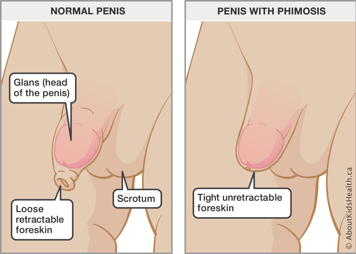What is Phimosis?
The penis is covered by a ring of tissue called the foreskin. The foreskin is loose. It slides over the penis, covering and uncovering the head of the penis (glans). It can also cover and uncover the opening of the penis (meatus). However, if the foreskin is too tight, it is unable to move. When this happens, the foreskin can close over the glans, causing a condition called phimosis. As a result, a tight ring of scar tissue forms over the head of the penis (glans), which prevents the foreskin from retracting from the glans.
The severity of phimosis varies:
- In milder forms of phimosis, the foreskin retracts partially.
- In severe phimosis, the foreskin cannot retract. It completely closes the penis (meatus).
If your child has phimosis, a doctor will refer him to an urologist.

How common is phimosis?
In the United States, about 10% of boys are born with phimosis. A larger percentage of boys are born with a milder form of phimosis, in which the foreskin can only partially retract.
Normally, by the time a boy reaches 16 years of age, he should be able to easily retract his foreskin. This is true in 1% to 5% of men. If they cannot retract the foreskin by this age, they may possibly have phimosis.
Phimosis can occur naturally
Some boys are born with phimosis. This is called physiological phimosis because it occurs naturally. As the fetus develops, the foreskin attaches to the glans. The symptoms of phimosis become noticeable around three years of age.
Signs of physiological phimosis include:
- Inability to retract the foreskin while cleaning or bathing
- Ballooning of the foreskin while urinating
Treating physiological phimosis
The foreskin slowly detaches from the glans over time. Since it resolves on its own as the child gets older, there is no need for treatment. However, if a child forcefully retracts the foreskin, the phimosis can worsen.
Phimosis can develop over time
Other boys develop the condition when they are older. When this happens, it is called pathological phimosis. It usually develops after puberty. Boys find they are unable to retract the foreskin. This is often the result of:
- poor hygiene. Proper foreskin care can help.
- repeated swelling of the foreskin and penis glans. This condition is a common foreskin problem called balantis.
- the foreskin becomes scarred, and over time phimosis develops.
Signs and symptoms of pathological phimosis include:
- the foreskin completely blocks the penis glans
- painful erections
- bleeding
- repeated infections of the bladder or kidneys (urinary tract infections)
- inflammation in the skin penis glans (balantis)
- pain in the foreskin
- difficulty urinating or weak flow of urine
Treating pathological phimosis
Pathological phimosis is usually easily treatable. It rarely requires an emergency intervention. There are two forms of treatment:
- Topical steroids. Applying topical steroids to the foreskin is an effective form of treatment. It needs to be applied twice a day for four to six weeks. Up to 85% of cases of mild-to-moderate phimosis respond well to this treatment. However, this treatment may be temporary. Sometimes, the condition may reappear several months after completing treatment.
- Circumcision. If the foreskin still cannot be retracted using a topical steroid, your doctor may suggest circumcision. In this case, a surgeon may need to cut the trapped foreskin. This releases the constricting band on the foreskin. After surgery, there may be some complications. For instance, the penis may develop chronic infection or bleeding. Or the phimosis may come back.